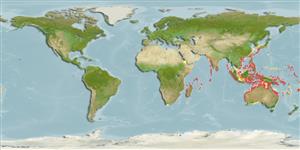Common names from other countries
Environment: milieu / climate zone / depth range / distribution range
Ecología
Asociado a arrecife; rango de profundidad 0 - 44 m (Ref. 81548). Tropical
Southeast Atlantic and Indo-West Pacific: South Africa to Australia and Japan.
Length at first maturity / Tamaño / Peso / Age
Maturity: Lm ? range ? - ? cm
Maximum length of arms: 3.0 cm. Associated with coral communities. Dwells in a variety of substrates. Feeds on encrusting turf over hard substrates (Ref. 129602). Occurs in healthy shallow reef areas at depths of 1 to 25 m.
Life cycle and mating behavior
Madurez | Reproducción | Puesta | Huevos | Fecundidad | Larva
Members of the class Asteroidea exhibit both asexual (regeneration and clonal) and sexual (gonochoric) means of reproduction. Life cycle: Embryos hatch into planktonic larvae and later metamorphose into pentamorous juveniles which develop into young sea stars with stubby arms.
Schoppe, S. 2000. (Ref. 800)
IUCN Red List Status (Ref. 130435)
CITES status (Ref. 108899)
Not Evaluated
Not Evaluated
Threat to humans
Harmless
Human uses
| FishSource |
Herramientas
Más información
Age/Size
Crecimiento
Length-weight
Length-length
Morfología
Larva
Abundancia
Fuentes de Internet
Estimates based on models
Preferred temperature
(Ref.
115969): 24.4 - 29, mean 27.8 (based on 836 cells).
Price category
Unknown.
